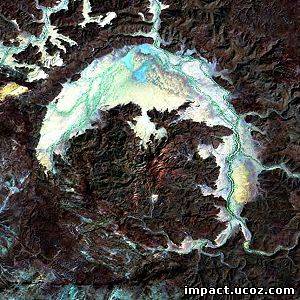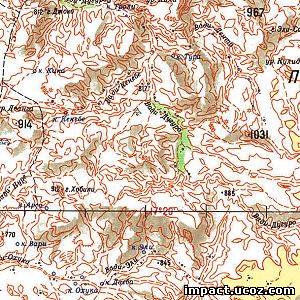- Vincent Pierre M., Beauvilain Alain (1996). Decouverte d'un nouveau
cratere d'impact meteoritique en Afrique: L'astrobleme de Gweni-Fada
(Ennedi, Sahara du Tchad). C. r. Acad. sci. Ser. 2. Fasc. a, Vol.323,
No.12, P. 987-997
- Vincent Pierre M., Beauvilain Alain (1996). Gweni-Fada (Ennedi,
Sahara du Tchad): Un nouvel astrobleme Africain. 16eme Reun. sci. terre
" Dyn. et econ. terre", Orleans , 10-12 avr., Paris: Soc. geol. Fr., P.
4
- Koeberl C., Reimold W.U., Vincent P.M., Brandt D.
(1998). Aorounga and Gweni Fada impact structures, Chad, Central Africa:
petrology and geochemistry of target rocks . Lunar and Planet. Sci.
Vol. 29. Abstr. Pap. 29th Lunar and Planet. Sci. Conf., March 16-20,
Houston (Tex.), P. 1103
- Jarmo Moilanen (2004). References.
- John
G. Spray, Director PASSC (2005). Impact Structures listed by Name.
Current total number of confirmed impact structures: 172 .
- Osinski Gordon R. (2006). The geological record of meteorite
impacts. 40th ESLAB First International Conference on Impact Cratering
in the Solar System, 8-12 May 2006., Noordwijk,The Netherlands
Gweni-Fada is a complex crater located in northern Chad. It was first
recognized through the study of aerial photos, and its impact origin
was later confirmed by a scientific expedition. The crater is 14km in
diameter, and has a pronounced central uplift structure. The target
rocks are Devonian sandstones. The outer rim is poorly defined in some
places, and is made up of dipping sandstone blocks. The annular trough
between the rim and the central uplift has an irregular crescent shape, a
diameter of 12km, and a maximum width of 4km in the north. The central
uplift structure has a diameter of 10km, and is made up of several
blocks of sandstone. Its topography is rugged, and includes summits
higher than the outer rim.
Gweni-Fada has a very small amount of impact deposits. No impact
melt bodies or impact breccias have been observed. Monomict breccias
were noticed in dyke zones, and appeared to be cataclasites. There is a
possibility that impactites exist and are buried under more recent
deposits, but drilling projects would be required to establish this.
Despite the lack of impact deposits, evidence of shock
metamorphism has been found at Gweni-Fada. Researchers have examined
rock samples from the central uplift structure, and quartz grains from
these rocks contain up to four sets of planar deformation features in
one grain.
The characteristics of Gweni-Fada have raised some interesting
questions about how impact craters form. In particular, the lack of
impactites and the large size of the central uplift structure are
considered unusual. These features have led some researchers to
speculate that these features occurred because Gweni-Fada may have
impacted into a water-laden sandstone body. The sandstones present in
this part of Chad are excellent aquifers now, despite the desert
climate. If the impact occurred into a water-rich rock, the material
ejected from the crater could have been in the form of fluidized flows,
instead of impactites. This would explain why there are no impactites
there now. In addition, craters on Mars with abnormally large central
structures show evidence of forming in a water-rich layer or target
rock. While this explanation for the features at Gweni-Fada is
intriguing, the possibility remains that the crater is simple abnormal,
and that the impactites have eroded. Since the age can only be
constrained to earlier than the Devonian, complete impactite erosion is a
possibility.
Global Impact Studies Project
 
Спутниковая фотография кратера из Google Earth.
| 
|
Обзор статей (из РЖ ВИНИТИ "Геология и геофизика"):
При изучении космоснимков в 30 км к С.-В. от гор. Фада была
обнаружена астроблема, чье наличие подтвердили дальнейшие исследования.
Структура расположена в субгоризонтально залегающих песчаниках девона,
минимальный диаметр - 14 км. Характерна асимметрия структуры, центр.
часть приподнята. Отчетливо прослеживаются две зоны - внешняя и
внутренняя, различные по своей структуре и морфологии. Основное
воздействие метаморфизма удара пришлось на породы в центральной зоне.
Рассмотрены детально изменения кварцевых зерен в песчаниках, отмечено
небольшое по объему образование расплава стекла. Ведутся работы по
установлению возраста метеоритного кратера
(Vincent Pierre M., Beauvilain Alain "Gweni-Fada (Ennedi, Sahara du Tchad)", 1996).
Кольцевая структура Гуэни-Фада расположена в с.-в. части
Республики Чад, ~ в 30 км с.-в. г. Фада. Миним. диаметр структуры,
выработанной в песчаниках верхнего девона, достигает 14 км; эта
структура является четвертой по размеру астроблемой, известной в
настоящее время в Африке. Характерной чертой структуры является ее
асимметричное строение и наличие крупного центр. поднятия. Окружающая
астроблему депрессия имеет форму полумесяца, вытянутого в меридиональном
направлении и открытого на В. В центр. зоне структуры располагается
поднятие, возвышающееся над окружающим астроблему валом. В породах,
вмещающих астроблему, выявлены следы ударного метаморфизма.
(Vincent Pierre M., Beauvilain Alain, 1996).
|